Kampos: The Secret Life of Chios’s Citrus Estates
As its historic estates fade and...

© Perikles Merakos
Apano Meria encompasses 22 square kilometers, forming the northern half of Syros. Traditionally the agricultural heartland for the residents of Ano Syros, it remains one of the most untouched regions in the Cyclades. As part of the Natura 2000 protected network, Apano Meria is one of the most preserved regions in the Cyclades, with limited paved roads leading from Ano Syros to small villages like San Michalis and Kampos. Ancient trails, still traversed by the island’s few remaining shepherds, wind through the landscape, revealing hidden spots and secluded corners that invite exploration.
Swiss geology professor Martin Engi Riedtmann, who has spent decades studying Syros’ geological formations, describes its geology as globally unique. Two rare rock types, eclogite and glaucophane schist, exemplify this distinctiveness.

The trail from Kampos to Lia Beach.
© Perikles Merakos
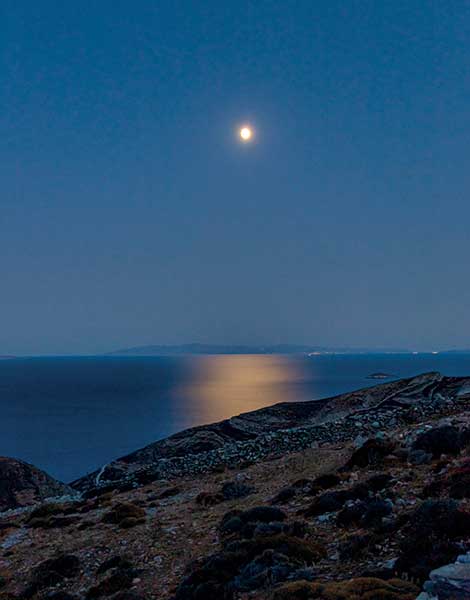
The moon rises over the Cycladic islands to the east of Syros.
© Perikles Merakos
Eclogite, originally a volcanic rock that was formed 40 to 50 million years ago, underwent a complete chemical transformation under immense pressure. Glaucophane schist, or blueschist, is known for its vibrant blue hue and was formed during the subduction of the African tectonic plate beneath the European plate. These remarkable formations emerged from depths of 80 kilometers, making them true geological wonders.
To celebrate and share the significance of these formations, Professor Engi, in collaboration with the University of the Aegean, is developing a network of geological trails and a visitor information center. These initiatives, expected to launch by autumn 2025, aim to offer visitors an opportunity to explore and appreciate Syros’ extraordinary geological heritage.
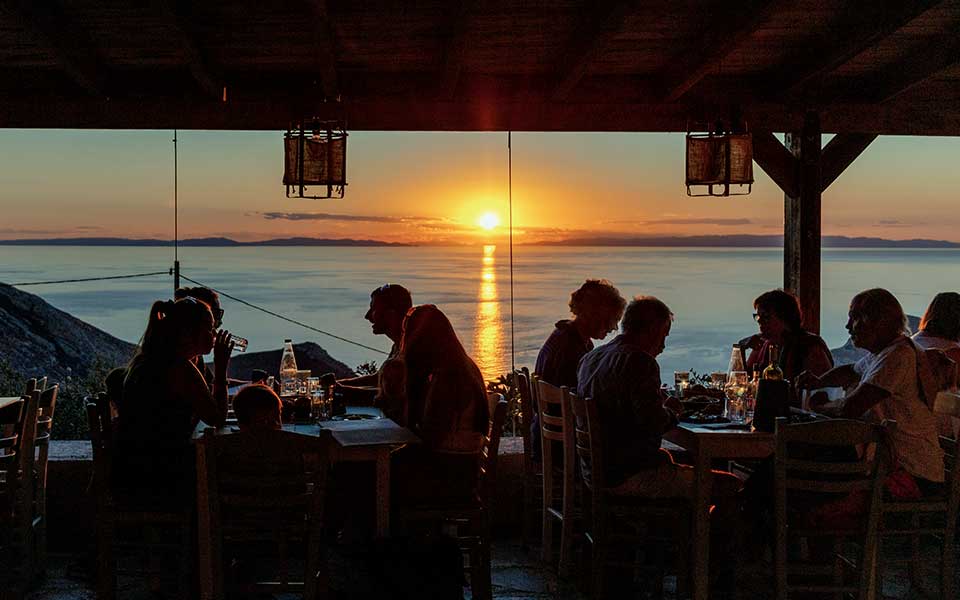
Sunset at Plakostroto Taverna in San Michalis.
© Perikles Merakos
The hiking trails of northern Syros beckon adventurers to explore their natural and cultural riches. The Social Cooperative Enterprise “Apano Meria,” dedicated to preserving and promoting this unique area, collaborates with the Syros Hiking Group to guide visitors through the region’s hidden gems. On a sunny September Sunday, I joined Io Stavridi, Marina Konstantopoulou, and Andrianos Pappas, members of “Apano Meria,” for a walk along the trail that begins in Kampos and ends at the secluded beach of Lia.
We greeted one of the island’s few remaining shepherds as he fed his sheep and goats, carefully securing the gate behind us to keep the animals in their pasture. As we descended, terraced fields once used for growing barley and vegetables came into view, interspersed with the aromatic scent of herbs thriving among the shrubs. The trail led us to an impressive, jet-black boulder standing tall like a natural menhir. Up close, its surface revealed a stunning play of colors – deep brown, green, purple, and crimson. This extraordinary rock was eclogite, one of the rarest and most remarkable geological formations of Apano Meria.
Further along, we encountered glaucophane schist, known for its vibrant blue tones, and the remains of an old lime kiln once used by locals to produce lime. Reaching the tranquil beach of Lia, Io explained that the lack of road infrastructure has been vital in preserving the untouched beauty of the northern beaches.
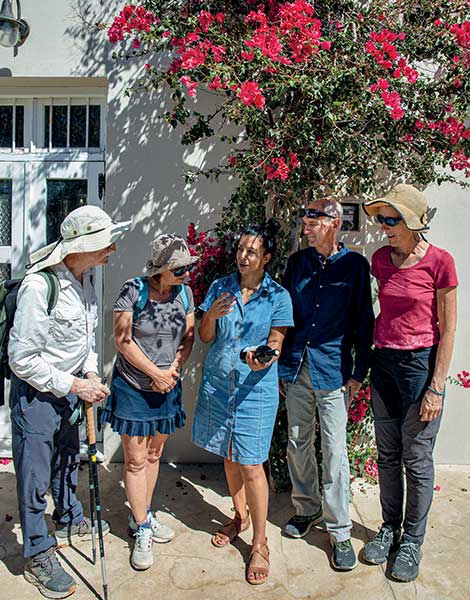
French travelers pause to discover the wines of Chatzakis Winery.
© Perikles Merakos
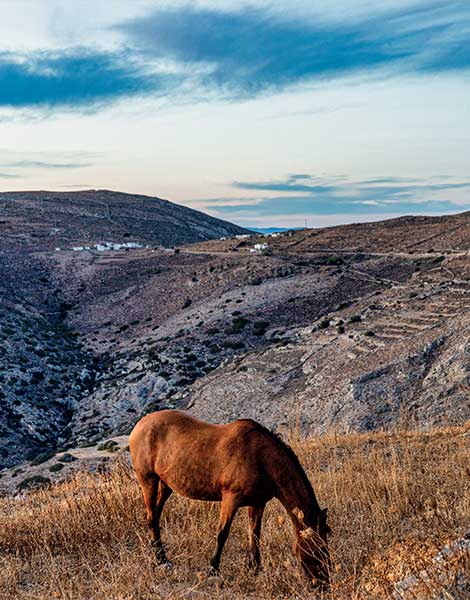
Elements of traditional rural life still endure in Apano Meria.
© Perikles Merakos
“Apano Meria” also organizes educational walks along the trail network, highlighting cultural and geological landmarks. These excursions often include raising awareness among schoolchildren about proper waste management and recycling, fostering a deeper appreciation for the environment.
One of the key venues for the cooperative’s cultural activities is Ktima Pomonia, situated at the edge of the Papouri settlement. Walking along a charming dry-stone wall, we arrived at a small farmhouse where Kostas Vasilakis, the owner, welcomed us. He recounted the summer concerts and cultural events held in the open-air theater, set against the stunning backdrop of the Aegean Sea and the island of Kea.
As we strolled among vineyards and fruit trees, signs of this summer’s prolonged drought were clear, underscoring the challenges faced by Syros’ organic farmers. The fragile local ecosystem also serves as a sanctuary for migratory birds, including buzzards, Montagu’s harriers, golden eagles, bee-eaters, and hoopoes, making Apano Meria a haven for nature lovers and birdwatchers alike.
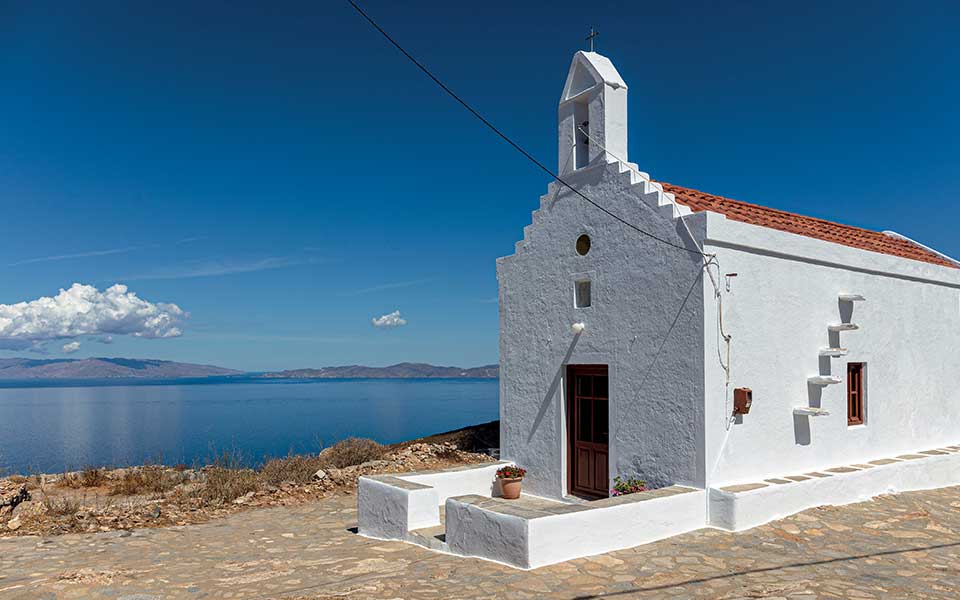
The Church of Aghios Michalis in the village of the same name.
© Perikles Merakos
Winding through the few paved kilometers of road, we arrive at San Michalis, the liveliest settlement in Apano Meria. The village, with its fewer than a dozen houses and shops, feels remarkably compact yet full of character. Life here moves to the rhythm of the semi-mountainous surroundings, offering residents the luxury of peace and quiet. Depending on which side of the village they call home, they are treated to views of neighboring islands either to the east or west.
San Michalis is also home to the winery of oenologist and winemaker Nikos Chatzakis, who made Syros his base in 2011. Beneath the fig tree where tastings take place, we hold up glasses of white wine, marveling at the greenish glint it takes on under the soft glow of Syros’ autumn skies.
On his 15,000-square-meter vineyard, Nikos cultivates primarily the Serifitiko grape, coaxing remarkable results from this indigenous Cycladic variety despite its natural limitations. His winery typically produces around 35,000 bottles annually, but this year’s harvest has been significantly reduced. Small-scale winemaking comes with its own set of challenges, from the impacts of climate change to a scarcity of labor. Yet, even in the face of adversity and growing demand, Nikos refuses to raise his prices. This philosophy perfectly mirrors the essence of Apano Meria: a place of rugged beauty and quiet resilience.
As we sit and watch fluffy white clouds reflected in the tranquil waters of the sea, a deep sense of calm washes over us. Here, despite the mounting pressures of the world, certain things remain unchanged – preserving their authentic charm and timeless allure.
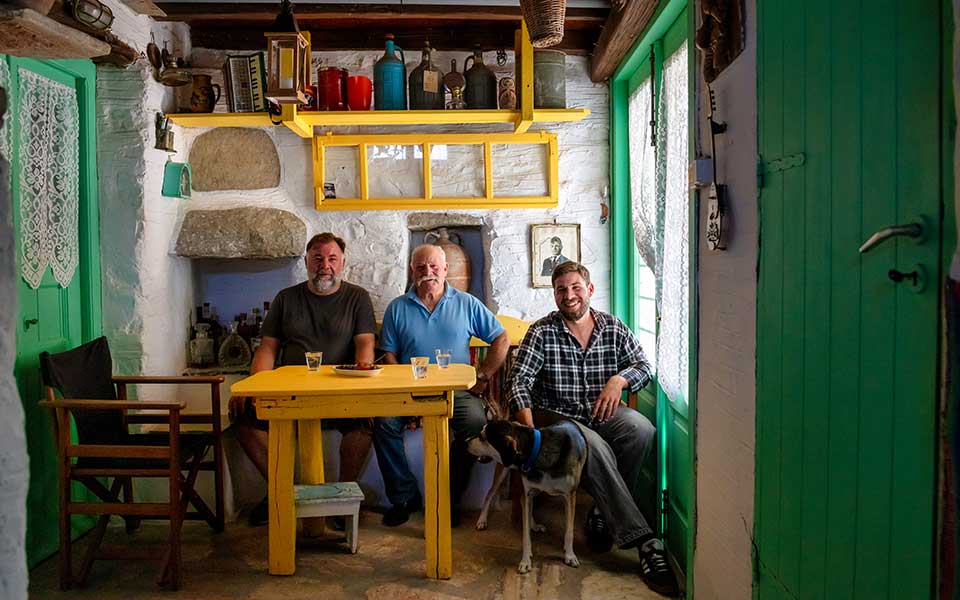
Mr. Fransiskos Palaiologos (center) at the traditional café Steadi.
© Perikles Merakos
Following the single narrow path that winds through San Michalis, we pass through a towering rock formation, emerging to a spectacular view of the sea, with Andros, Tinos, and Mykonos glimmering on the horizon. Beside the chapel of Aghios Michalis sits a stone-carved table, a relic of a simpler time when locals gathered here to chat, play tic-tac-toe, and lose themselves in the expanse of the Aegean.
A few steps away is Steadi, a family-run café that feels like stepping into a traditional Cycladic farmhouse. At its wooden gate, we are warmly greeted by Fransiskos, whose family – spanning three generations – shares captivating stories about this tiny settlement in Apano Meria. From the tale of the village’s only permanent resident who hasn’t left in 30 years, not even for a haircut, to the small-scale farmers preserving heirloom seeds and growing drought-resistant crops, the café feels like a living archive of local history.
Steadi takes its name from the traditional shelter that once protected villagers from fierce northern winds, serving as a gathering point for evening conversations. Its courtyard is adorned with artifacts from decades of agricultural life, while a carefully crafted opening in the eastern stone wall invites a cooling breeze and frames a perfect slice of the cobalt sky and sea – a serene moment suspended in time.

Eclogite is one of the rare rock formations found along the trail to Lia Beach.
© Perikles Merakos
This sense of tranquil isolation extends to the eastern reaches of San Michalis, where the historic sites of Chalandriani and Kastri are nestled. These Early Cycladic settlements, which flourished around 2300 BCE, include one of the largest prehistoric cemeteries in the Cyclades at Chalandriani. Despite their historical importance, both sites remain underexplored as tourist destinations. While parts of Chalandriani are accessible by road, the journey to Kastri requires a demanding hour-long hike, rewarding visitors with a profound connection to the island’s ancient past.
In the nearby village of Lygero, Cycladic gastronomy is given a modern twist. Here, chefs Theodoros Kassavetis and Stelios Theodorakis have opened their eponymous taverna, blending contemporary culinary creativity with the traditions of Apano Meria. They source meat from local farmers, bake dishes in a wood-fired oven, and embrace the region’s unhurried rhythm, creating a dining experience that feels both authentic and elevated.
As dusk falls and the sparse lights of the village flicker to life on the hillside, the moon rises from the sea, casting its glow across the quiet landscape. At this moment, the world seems to contract into the intimate scale of the Cyclades, a reminder that their enduring beauty lies in their simplicity and understated grandeur.
As its historic estates fade and...
The attention of the global fishing...
From kafeneia serving souma and meze...
On the Cycladic island of Tinos,...